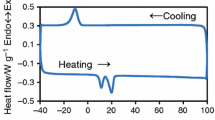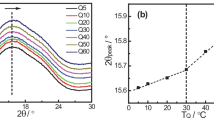Abstract
This study demonstrates that the step-heating calorimetry, which is a kind of temperature-modulated differential scanning calorimetry, can provide valuable information on the polymer melting. Time-dependent heat flow due to the melting of lamellar crystallites in a narrow range of thickness can be directly observed, from which thickness distribution of lamellar crystallites and thickness dependence of the melting kinetics are deduced. A sample of poly(ε-caprolactone) was used as a model material of semi-crystalline polymer, which has high crystallinity (0.79) so that no recrystallization and/or reorganization occur during melting in the step-heating scan. It was revealed that superheating dependence of the melting rate coefficient increases with increasing lamellar thickness, which may be attributed to variation of the fold surface roughness with respect to lamellar thickness. Analysis based on the cylindrical nucleation model revealed much lower free energy values of lateral surface than that evaluated from crystallization behavior, suggesting that the nucleus for melting is more stable than that for crystallization.






Similar content being viewed by others
References
Schawe JEK, Strobl GR. Superheating effects during the melting of crystallites of syndiotactic polypropylene analyzed by the temperature-modulated differential scanning calorimetry. Polymer. 1998;39:3745–51.
Toda A, Hikosaka M, Yamada K. Superheating of the melting kinetics in polymer crystals: a possible nucleation mechanism. Polymer. 2002;43:1667–79.
Wurm A, Schick C. Reversing and nonreversing contributions to polymer melting. Colloid Polym Sci. 2003;281:113–22.
Salmerón Sánchez M, Gómez Ribelles JL, Hernández Sánchez F, Mano JF. On the kinetics of melting and crystallization of poly(l-lactic acid) by TMDSC. Thermochim Acta. 2005;430:201–10.
Rastogi S, Lippits DR, Höhne GWH, Mezari B, Magusin PCMM. The role of the amorphous phase in melting of linear UHMW-PE; implications for chain dynamics. J Phys Cond Mat. 2007;19:205122.
Toda A, Kojima I, Hikosaka M. Melting kinetics of polymer crystals with an entropic barrier. Macromolecules. 2008;41:120–7.
Yasuniwa M, Sakamo K, Ono Y, Kawahara W. Melting behavior of poly(l-lactic acid): X-ray and DSC analyses of the melting process. Polymer. 2008;49:1943–51.
Rastogi S, Yao Y, Lippits DR, Höhne GWH, Graf R, Spiess HW, Lemstra PJ. Segmental mobility in the non-crystalline regions of semicrystalline polymers and its implications on melting. Macromol Rapid Commun. 2009;30:826–39.
Pandey A, Toda A, Rastogi S. Influence of amorphous component on melting of semicrystalline polymers. Macromolecules. 2011;44:8042–55.
Hu W, Frenkel D, Mathot VBF. Free energy barrier to melting of single-chain polymer crystallite. J Chem Phys. 2003;118:3455–7.
Ren Y, Ma A, Li J, Jiang X, Ma Y, Toda A, Hu W. Melting of polymer single crystals studied by dynamic Monte Carlo simulations. Eur Phys J E. 2010;33:189–202.
Minakov AA, Mordvintsev DA, Schick C. Melting and reorganization of poly(ethylene terephthalate) on fast heating (1000 K/s). Polymer. 2004;45:3755–63.
Minakov AA, van Herwaarden AW, Wien W, Wurm A, Schick C. Advanced nonadiabatic ultrafast nanocalorimetry and superheating phenomenon in linear polymers. Thermochim Acta. 2007;461:96–106.
Minakov AA, Wurm A, Schick C. Superheating in linear polymers studied by ultrafast nanocalorimetry. Eur Phys J E. 2007;23:43–53.
Jin ZH, Gumbsch P, Lu K, Ma E. Melting mechanisms at the limit of superheating. Phys Rev Lett. 2001;87:055703.
Forsblom M, Grimvall G. Homogeneous melting of superheated crystals: molecular dynamics simulations. Phys Rev B. 2005;72:054107.
Pielichowski K, Flejtuch K, Pielichowski J. Step-scan alternating DSC study of melting and crystallisation in poly(ethylene oxide). Polymer. 2004;45:1235–42.
Armitstead K, Goldbeck-Wood G. Polymer crystallization theories. Adv Polym Sci. 1992;100:219–312.
Chatani Y, Okita Y, Tadokoro H, Yamashita Y. Structural studies of polyesters. III. Crystal structure of poly-ε-caprolactone. Polym J. 1970;1:555–62.
Guo Q, Groeninckx G. Crystallization kinetics of poly(ε-caprolactone) in miscible thermosetting polymer blends of epoxy resin and poly(ε-caprolactone). Polymer. 2001;42:8647–55.
Pyda M. Ed. ATHAS Data Bank; http://athas.prz.rzeszow.pl..
Lippits DR, Rastogi S, Höhne GWH. Melting kinetics in polymers. Phys Rev Lett. 2006;96:218303.
Sohn S, Alizadeh A, Marand H. On the multiple melting behavior of bisphenol-A polycarbonate. Polymer. 2000;41:8879–86.
Sasaki T, Sunago H, Hoshikawa T. Multiple melting behavior of syndiotactic 1,2-polybutadiene. Polym Eng Sci. 2003;43:629–38.
Voigt-Martin IG, Peacock AJ, Mandelkern L. A comparison of the Raman LAM and electron microscopy in determining crystallite thickness distributions: polyethylenes with narrow size distributions. J Polym Sci B Polym Phys. 1989;27:957–65.
Voigt-Martin IG, Mandelkern L. Numerical analysis of lamellar thickness distributions. J Polym Sci B Polym Phys. 1989;27:967–91.
Lu L, Alamo RG, Mandelkern L. Lamellar thickness distributions in linear polyethylene and ethylene copolymers. Macromolecules. 1994;27:6571–6.
Acknowledgements
The author thanks Hiroyuki Kaneko, Aoto Kakinoki, and Hiroaki Matsuura for help in DSC measurements.
Author information
Authors and Affiliations
Corresponding author
Rights and permissions
About this article
Cite this article
Sasaki, T. Melting of poly(ε-caprolactone) studied by step-heating calorimetry. J Therm Anal Calorim 111, 717–724 (2013). https://doi.org/10.1007/s10973-012-2209-6
Received:
Accepted:
Published:
Issue Date:
DOI: https://doi.org/10.1007/s10973-012-2209-6




